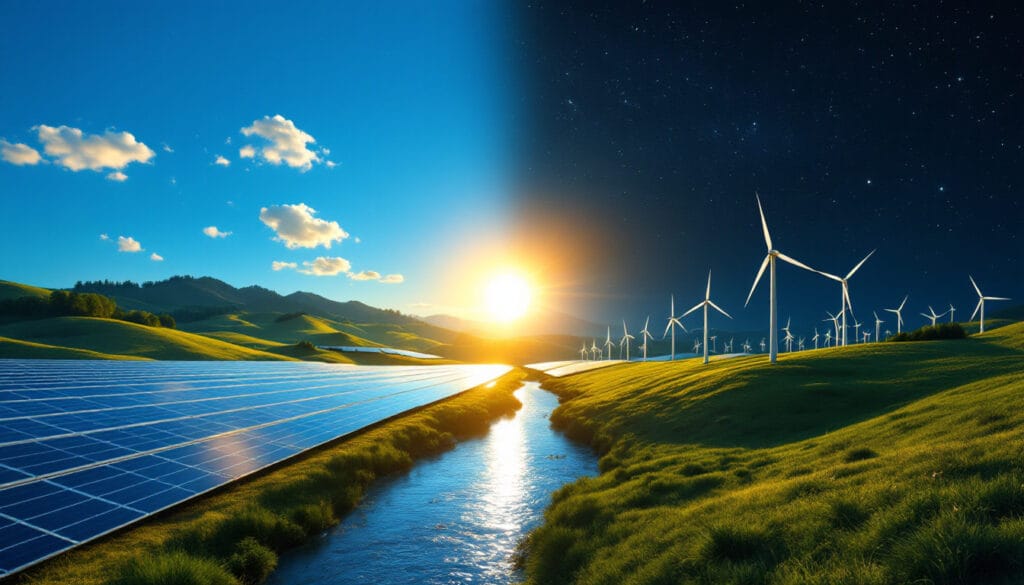At the crossroads between seawater and freshwater, a burgeoning source of renewable energy appears: blue energy, also known as osmotic energy. This natural phenomenon, arising from the difference in salinity between these two types of water, offers a unique opportunity to produce energy in mechanical or electrical form. By unlocking the secrets of salinity gradients, this untapped energy source could transform our perspective on renewable sources while contributing to the reduction of greenhouse gases. In this fascinating realm, osmosis plays a central role by triggering electric currents capable of powering our ecological dreams.
Blue energy, sometimes referred to as osmotic energy, is an emerging form of renewable energy distinguished by its unique source: the difference in salinity between freshwater and seawater. At the confluence of these two environments, a natural osmotic reaction occurs, enabling energy generation. This encounter gives rise to what is called salinity gradient energy.
At the interface between rivers and seas, where salty seawater and freshwater mix, an immense amount of energy is potentially exploitable. This natural phenomenon is related to osmosis, a process by which particles move through a permeable membrane from a low concentration solution to a high concentration solution. By capturing this process, osmotic energy can be converted into either mechanical energy or electrical energy.
The potential applications of blue energy are numerous and promising. Indeed, these systems could be integrated into coastal energy devices to actively contribute to renewable energy production while providing an ecological alternative to traditional methods. Currently explored technologies focus on harnessing these differences in salinity to generate constant and clean electric currents.
One of the major strengths of blue energy is its potential to produce energy without emitting greenhouse gases. Thus, it represents a potential solution for positively influencing global warming. Unlike fossil fuels that pollute the atmosphere by releasing CO2, osmotic energy is environmentally friendly, making it attractive for sustainable development initiatives.
Despite its many advantages, blue energy poses challenges and disadvantages to overcome. The development of osmotic plants requires not only complex and costly technology but also appropriate infrastructure to successfully carry out salinity gradient exploitation projects. To date, the energy yield of these plants remains limited, necessitating ongoing research and development to maximize their efficiency.
Finally, although enthusiasm for blue energy is palpable, it remains at a preliminary stage of development. Its recognition as a significant renewable energy source at a large scale will depend on technological advancements and investment in research to optimize the exploitation of this natural phenomenon. The potential of this energy to reshape the energy landscape of the future is undeniable, but it remains to be realized.

FAQ: Understanding Blue Energy
Q: What is blue energy?
A: Blue energy, also known as osmotic energy, is a form of renewable energy produced from the difference in salinity between freshwater and seawater. This energy is generated when these two types of water meet.
Q: What is the origin of osmotic energy?
A: Osmotic energy is created at the boundary between the seas and rivers where osmosis occurs, thus allowing energy to be recovered in mechanical or electrical form.
Q: How does an osmotic power plant work?
A: An osmotic power plant works by exploiting the difference in salt concentration between freshwater and seawater. This difference creates a flow of water that can be converted into electricity.
Q: Why is blue energy considered renewable?
A: Blue energy is renewable because it harnesses a natural and continuous process of freshwater and saltwater mixing. Moreover, it does not emit greenhouse gases, thus contributing to slowing down global warming.
Q: What are the applications of blue energy?
A: Blue energy can be used to generate clean electricity. It has significant potential to power coastal and urban infrastructures while reducing the carbon footprint.
Q: What are the main advantages of osmotic energy?
A: The main advantages of osmotic energy include its renewable nature, the reduction of greenhouse gas emissions, and the ability to provide a constant and stable energy source, independent of weather conditions.
Articles similaires
Thank you!
We will contact you soon.













